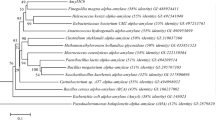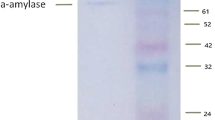Abstract
The hyperthermophilic α-amylase from Thermococcus sp. HJ21 does not require exogenous calcium ions for thermostability, and is a promising alternative to commercially available α-amylases to increase the efficiency of industrial processes like the liquefaction of starch. We analyzed the amino acid sequence of this α-amylase by sequence alignments and structural modeling, and found that this α-amylase closely resembles the α-amylase from Pyrococcus woesei. The gene of this α-amylase was cloned in Escherichia coli and the recombinant α-amylase was overexpressed and purified with a combined renaturation-purification procedure. We confirmed thermostability and exogenous calcium ion independency of the recombinant α-amylase and further investigated the mechanism of the independency using biochemical approaches. The results suggested that the α-amylase has a high calcium ion binding affinity that traps a calcium ion that would not dissociate at high temperatures, providing a direct explanation as to why the addition of calcium ions is not required for thermostability. Understanding of the mechanism offers a strong base on which to further engineer properties of this α-amylase for better potential applications in industrial processes.
Similar content being viewed by others
References
Chai, K.P., Othman, N.F., Teh, A.H., Ho, K.L., Chan, K.G., Shamsir, M.S., Goh, K.M., and Ng, C.L. 2016. Crystal structure of Anoxybacillus α-amylase provides insights into maltose binding of a new glycosyl hydrolase subclass. Sci. Rep. 6, 23126.
Choi, K.H., Hwang, S., Lee, H.S., and Cha, J. 2011. Identification of an extracellular thermostable glycosyl hydrolase family 13 α-amylase from Thermotoga neapolitana. J. Microbiol. 49, 628–634.
Chung, Y.C., Kobayashi, T., Kanai, H., Akiba, T., and Kudo, T. 1995. Purification and properties of extracellular amylase from the hyperthermophilic archaeon Thermococcus profundus DT5432. Appl. Environ. Microbiol. 61, 1502–1506.
Davies, G. and Henrissat, B. 1995. Structures and mechanisms of glycosyl hydrolases. Structure 3, 853–859.
Deb, P., Talukdar, S.A., Mohsina, K., Sarker, P.K., and Sayem, S.A. 2013. Production and partial characterization of extracellular amylase enzyme from Bacillus amyloliquefaciens P-001. SpringerPlus 2, 154.
Dong, G.Q., Vieille, C., Savchenko, A., and Zeikus, J.G. 1997. Cloning, sequencing, and expression of the gene encoding α-amylase from Pyrococcus furiosis and biochemical characterisation of the recombinant enzyme. Appl. Environ. Microbiol. 63, 3569–3576.
Edgar, R.C. 2004. MUSCLE: multiple sequence alignment with high accuracy and high throughput. Nucleic Acids Res. 32, 1792–1797.
Gupta, R., Gigras, P., Mohapatra, H., Goswami, V.K., and Chauhan, B. 2003. Microbial α-amylases. a biotechnological perspective. Process Biochem. 38, 1599–1616.
Johnson, K.A. 2013. A century of enzyme kinetic analysis, 1913 to 2013. FEBS Lett. 587, 2753–2766.
Kamitori, S., Abe, A., Ohtaki, A., Kaji, A., Tonozuka, T., and Sakano, Y. 2002. Crystal structures and structural comparison of Thermoactinomyces vulgaris R-47 alpha-amylase 1 (TVAI) at 1.6 A resolution and alpha-amylase 2 (TVAII) at 2.3 A resolution. J. Mol. Biol. 318, 443–453.
Koch, R., Spreinat, A., Lemke, K., and Antranikian, G. 1991. Purification and properties of a hyperthermoactive α-amylase from the archaeobacterium Pyrococcus woesei. Arch. Microbiol. 155, 572–578.
Leveque, E., Haye, B., and Belarbi, A. 2000. Cloning and expression of an alpha-amylase encoding gene from the hyperthermophilic archaebacterium Thermococcus hydrothermalis and biochemical characterisation of the recombinant enzyme. FEMS Microbiol. Lett. 186, 67–71.
Li, Z., Duan, X., and Wu, J. 2016. Improving the thermostability and enhancing the Ca2+ binding of the maltohexaose-forming alpha-amylase from Bacillus stearothermophilus. J. Biotechnol. 222, 65–72.
Linden, A., Mayans, O., Meyer-Klaucke, W., Antranikian, G., and Wilmanns, M. 2003. Differential regulation of a hyperthermophilic alpha-amylase with a novel (Ca,Zn) two-metal center by zinc. J. Biol. Chem. 278, 9875–9884.
Linden, A., Niehaus, F., and Antranikian, G. 2000. Single-step purification of a recombinant thermostable α-amylase after solubilization of the enzyme from insoluble aggregates. J. Chromatogr. B 737, 253–259.
Machius, M., Declerck, N., Huber, R., and Wiegand, G. 1998. Activation of Bacillus licheniformis α-amylase through a disorder → order transition of the substrate-binding site mediated by a calcium-sodium-calcium metal triad. Structure 6, 281–292.
Marti-Renom, M.A., Stuart, A.C., Fiser, A., Sanchez, R., Melo, F., and Sali, A. 2000. Comparative protein structure modeling of genes and genomes. Annu. Rev. Biophys. Biomol. Struct. 29, 291–325.
Miller, G.L. 1959. Use of dinitrosalicylic acid reagent for determination of reducing sugar. Anal. Chem. 31, 426–428.
Pujadas, G. and Palau, J. 2001. Evolution of alpha-amylases: architectural features and key residues in the stabilization of the (ß/a)8 scaffold. Mol. Biol. Evol. 18, 38–54.
Richardson, T.H., Tan, X., Frey, G., Callen, W., Cabell, M., Lam, D., Macomber, J., Short, J.M., Robertson, D.E., and Miller, C. 2002. A novel, high performance enzyme for starch liquefaction. Discovery and optimization of a low pH, thermostable α-amylase. J. Biol. Chem. 277, 26501–26507.
Savchenko, A., Vieille, C., Kang, S., and Zeikus, J.G. 2002. Pyrococcus furiosus alpha-amylase is stabilized by calcium and zinc. Biochemistry 41, 6193–6201.
Sharma, A. and Satyanarayana, T. 2012. Cloning and expression of acidstable, high maltose-forming, Ca2+-independent α-amylase from an acidophile Bacillus acidicola and its applicability in starch hydrolysis. Extremophiles 16, 515–522.
Vieille, C. and Zeikus, G.J. 2001. Hyperthermophilic enzymes: sources, uses, and molecular mechanisms for thermostability. Microbiol. Mol. Biol. Rev. 65, 1–43.
Violet, M. and Meunier, J.C. 1989. Kinetic study of the irreversible thermal denaturation of Bacillus licheniformis α-amylase. Biochem. J. 263, 665–670.
Wang, S., Lu, Z., Lu, M., Qin, S., Liu, H., Deng, X., Lin, Q., and Chen, J. 2008. Identification of archaeon-producing hyperthermophilic α-amylase and characterization of the α-amylase. Appl. Microbiol. Biotechnol. 80, 605–614.
Ying, Q., Zhang, C., Guo, F., Wang, S., Bie, X., Lu, F., and Lu, Z. 2012. Secreted expression of a hyperthermophilic alpha-amylase gene from Thermococcus sp. HJ21 in Bacillus subtilis. J. Mol. Microbiol. Biotechnol. 22, 392–398.
Author information
Authors and Affiliations
Corresponding authors
Rights and permissions
About this article
Cite this article
Cheng, H., Luo, Z., Lu, M. et al. The hyperthermophilic α-amylase from Thermococcus sp. HJ21 does not require exogenous calcium for thermostability because of high-binding affinity to calcium. J Microbiol. 55, 379–387 (2017). https://doi.org/10.1007/s12275-017-6416-5
Received:
Revised:
Accepted:
Published:
Issue Date:
DOI: https://doi.org/10.1007/s12275-017-6416-5




